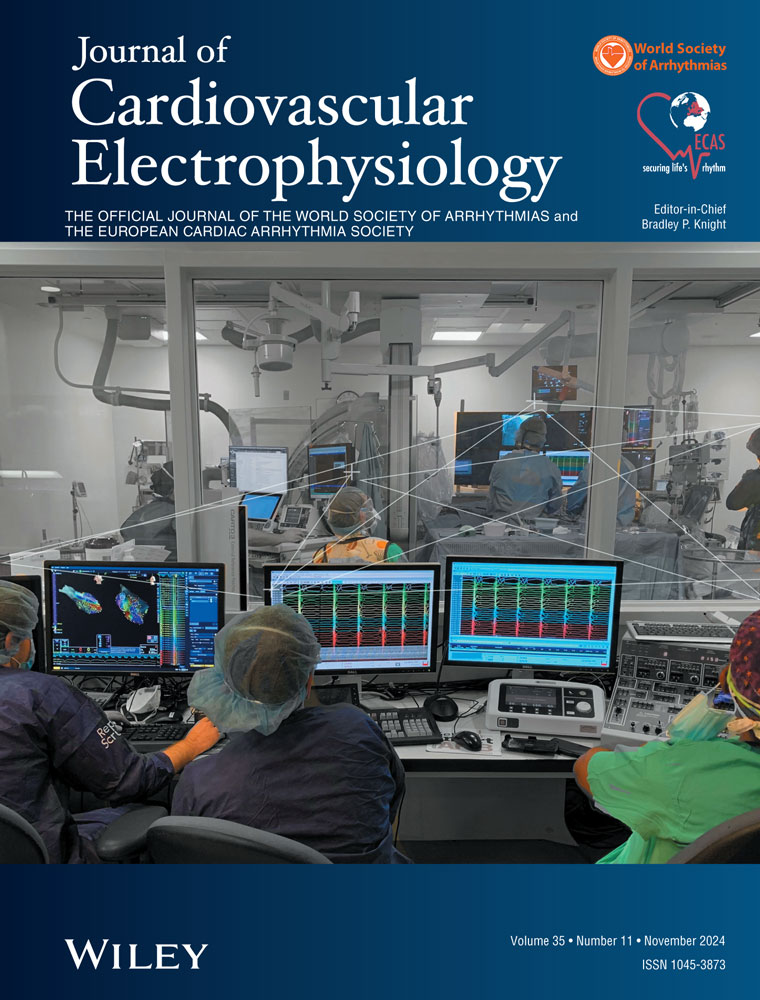What is the mechanism of this narrow QRS tachycardia in a patient with type-A Wolff-Parkinson-White (WPW) syndrome?
Yuji Saito MD, PhD
Division of Cardiology, Department of Medicine, Nihon University School of Medicine, Tokyo, Japan
Search for more papers by this authorCorresponding Author
Koichi Nagashima MD, PhD
Division of Cardiology, Department of Medicine, Nihon University School of Medicine, Tokyo, Japan
Correspondence Koichi Nagashima, MD, PhD, Division of Cardiology, Department of Medicine, Nihon University School of Medicine, 30-1 Ohyaguchi-kamicho, Itabashi-ku, Tokyo 173-8610, Japan.
Email: [email protected]
Search for more papers by this authorYuji Wakamatsu MD, PhD
Division of Cardiology, Department of Medicine, Nihon University School of Medicine, Tokyo, Japan
Search for more papers by this authorShu Hirata MD
Division of Cardiology, Department of Medicine, Nihon University School of Medicine, Tokyo, Japan
Search for more papers by this authorRyuta Watanabe MD, PhD
Division of Cardiology, Department of Medicine, Nihon University School of Medicine, Tokyo, Japan
Search for more papers by this authorNaoto Otsuka MD, PhD
Division of Cardiology, Department of Medicine, Nihon University School of Medicine, Tokyo, Japan
Search for more papers by this authorMoyuru Hirata MD
Division of Cardiology, Department of Medicine, Nihon University School of Medicine, Tokyo, Japan
Search for more papers by this authorMasanaru Sawada MD
Division of Cardiology, Department of Medicine, Nihon University School of Medicine, Tokyo, Japan
Search for more papers by this authorSayaka Kurokawa MD, PhD,
Division of Cardiology, Department of Medicine, Nihon University School of Medicine, Tokyo, Japan
Search for more papers by this authorYasuo Okumura MD, PhD
Division of Cardiology, Department of Medicine, Nihon University School of Medicine, Tokyo, Japan
Search for more papers by this authorYuji Saito MD, PhD
Division of Cardiology, Department of Medicine, Nihon University School of Medicine, Tokyo, Japan
Search for more papers by this authorCorresponding Author
Koichi Nagashima MD, PhD
Division of Cardiology, Department of Medicine, Nihon University School of Medicine, Tokyo, Japan
Correspondence Koichi Nagashima, MD, PhD, Division of Cardiology, Department of Medicine, Nihon University School of Medicine, 30-1 Ohyaguchi-kamicho, Itabashi-ku, Tokyo 173-8610, Japan.
Email: [email protected]
Search for more papers by this authorYuji Wakamatsu MD, PhD
Division of Cardiology, Department of Medicine, Nihon University School of Medicine, Tokyo, Japan
Search for more papers by this authorShu Hirata MD
Division of Cardiology, Department of Medicine, Nihon University School of Medicine, Tokyo, Japan
Search for more papers by this authorRyuta Watanabe MD, PhD
Division of Cardiology, Department of Medicine, Nihon University School of Medicine, Tokyo, Japan
Search for more papers by this authorNaoto Otsuka MD, PhD
Division of Cardiology, Department of Medicine, Nihon University School of Medicine, Tokyo, Japan
Search for more papers by this authorMoyuru Hirata MD
Division of Cardiology, Department of Medicine, Nihon University School of Medicine, Tokyo, Japan
Search for more papers by this authorMasanaru Sawada MD
Division of Cardiology, Department of Medicine, Nihon University School of Medicine, Tokyo, Japan
Search for more papers by this authorSayaka Kurokawa MD, PhD,
Division of Cardiology, Department of Medicine, Nihon University School of Medicine, Tokyo, Japan
Search for more papers by this authorYasuo Okumura MD, PhD
Division of Cardiology, Department of Medicine, Nihon University School of Medicine, Tokyo, Japan
Search for more papers by this authorDisclosures: None.
CONFLICT OF INTEREST STATEMENT
The authors declare no conflicts of interest.
Open Research
DATA AVAILABILITY STATEMENT
The data that support the findings of this study are available on request from the corresponding author. The data are not publicly available due to privacy or ethical restrictions.
REFERENCES
- 1Nagashima K, Michaud GF, Ho RT, Okumura Y. SVT quest: the adventure diagnosing narrow QRS tachycardia. J Arrhythm. 2024; 40(4): 767-785. doi:10.1002/joa3.13112
- 2Nagashima K, Maruyama M, Kaneko Y, et al. Response to Para-Hisian pacing in the setting of presence of a concealed nodoventricular/nodofascicular pathway. JACC Clin Electrophysiol. 2023; 9(2): 283-296.
- 3Nagashima K, Maruyama M, Kaneko Y, et al. Systematic observation-based diagnosis of atrioventricular nodal reentrant tachycardia with a bystander concealed nodoventricular pathway. J Arrhythm. 2024; 40(1): 131-142.
- 4Nagashima K, Kaneko Y, Maruyama M, et al. Novel diagnostic observations of nodoventricular/nodofascicular pathway-related orthodromic reciprocating tachycardia differentiating from atrioventricular nodal re-entrant tachycardia. JACC Clin Electrophysiol. 2020; 6(14): 1797-1807.
- 5Cardona-Guarache R, Han FT, Nguyen DT, et al. Ablation of supraventricular tachycardias from concealed left-sided nodoventricular and nodofascicular accessory pathways. Circ Arrhythm Electrophysiol. 2020; 13(5):e007853.
- 6Ho RT, Ortman M, Levi SA. The various manifestations of concealed nodofascicular/nodoventricular bypass tracts. Heart Rhythm. 2020; 17(8): 1280-1290.




